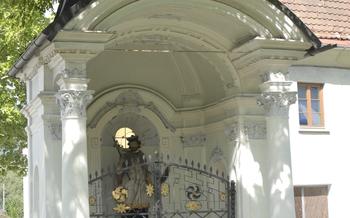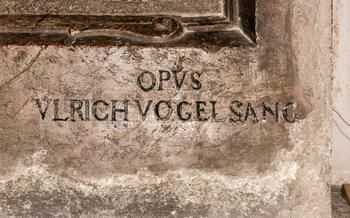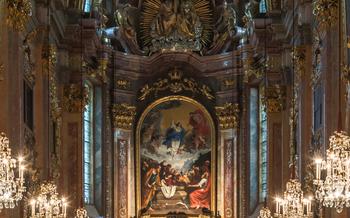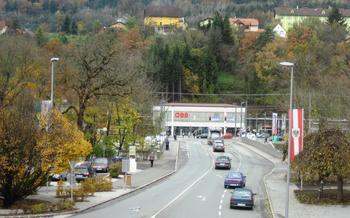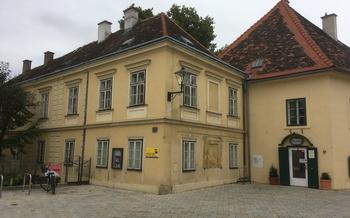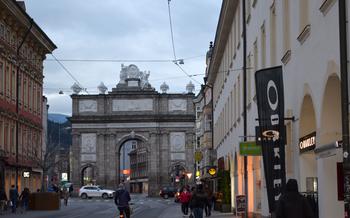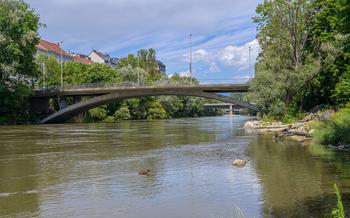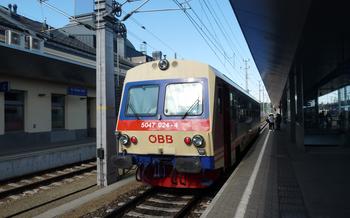
St. Magdalena's Church
- History of St. Magdalena's Church
- The Church's Exterior
- The Church's Interior
- The Altar and Altarpiece: A Masterpiece of Sacred Art
- The Organ
- The Frescoes
- The Stained Glass Windows
- The Sculptures
- The Crypts
- The Pilgrimage Route
- Photography and Videography
- Local Festivals and Events
- Insider Tip: Discover the Hidden Gem of the Church's Gardens
History of St. Magdalena's Church
St. Magdalena's Church, a magnificent architectural masterpiece nestled in the heart of Hall in Tirol, Austria, holds a rich and storied history. Its origins can be traced back to the 14th century when it was initially constructed as a small chapel dedicated to St. Magdalene. Over time, the chapel underwent several expansions and renovations, transforming it into the grand and awe-inspiring church that stands today. In the 15th century, the church was significantly enlarged and adorned with intricate Gothic elements, reflecting the prevailing architectural style of the era. During the 17th century, the church underwent a Baroque transformation, characterized by the addition of opulent decorations, elaborate frescoes, and a stunning high altar. These renovations and expansions not only enhanced the beauty and grandeur of the church but also cemented its position as a significant spiritual and cultural landmark in the region.
The Church's Exterior
The exterior of St. Magdalena's Church is a testament to the architectural grandeur of the Gothic period. The striking facade, adorned with intricate carvings and delicate tracery, captivates the eyes of visitors. The church's bell tower, a symbol of its spiritual presence, rises majestically above the town, beckoning the faithful to prayer. The stained glass windows, with their vibrant colors and intricate designs, cast a warm glow on the interior, creating an atmosphere of awe and reverence.
The church's exterior is a canvas of religious symbolism and iconography. The carvings on the facade depict scenes from the Bible, reminding visitors of the church's dedication to spreading the Christian faith. The bell tower, with its pointed spire, symbolizes the church's connection to the heavens. The stained glass windows, adorned with images of saints and biblical figures, serve as a visual reminder of the church's commitment to teaching and preserving the teachings of Christianity.
The Church's Interior
Stepping inside St. Magdalena's Church is a truly awe-inspiring experience. The grandnave, with its soaring ceilings and elegant arches, creates a sense of immense space and reverence. The focal point of the interior is the magnificent high altar, an exquisite masterpiece of intricate carvings, gold leaf decorations, and vibrant colors.
The altar, a testament to the artistry of the Baroque era, depicts scenes from the life of Christ, with each intricate detail conveying a profound theological message. Surrounding the altar are exquisite frescoes, paintings, and sculptures, each telling a unique story from the Bible. The walls and ceilings are adorned with vibrant frescoes, depicting scenes from the Old and New Testaments, rendered with remarkable skill and attention to detail.
Of particular note are the stunning stained glass windows, which illuminate the church's interior with a kaleidoscope of colors. These intricate windows, depicting biblical scenes and figures, cast a warm, ethereal glow upon the church, creating an atmosphere of serenity and contemplation.
The Altar and Altarpiece: A Masterpiece of Sacred Art
The centerpiece of St. Magdalena's Church is undoubtedly the grand altar, a stunning work of art that captivates the eyes of all who enter. Crafted from the finest materials, the altar features intricate carvings that showcase the exceptional craftsmanship of its creators. Gold leaf adorns its surface, reflecting the flickering light of candles and creating an ethereal glow.
The altarpiece, which serves as the focal point of the altar, is a masterpiece of sacred art. Its vibrant colors and intricate details depict scenes from the life of Jesus Christ and the saints, inviting viewers to contemplate their faith and the divine. The altarpiece is a testament to the artistry and devotion of the church's patrons, who spared no expense in creating this magnificent work of art.
The stories and symbolism depicted in the altarpiece are a testament to the church's rich history and traditions. Each panel tells a tale from the Bible, offering a glimpse into the lives of holy figures and the teachings of Christianity. The altarpiece serves as a visual reminder of the church's mission to spread the word of God and inspire its congregation to follow in the footsteps of the saints.
Visitors to St. Magdalena's Church are in awe of the stunning altar and altarpiece. The intricate carvings, gold leaf decorations, and vibrant colors combine to create a sense of awe and reverence. The altarpiece, with its biblical scenes and symbolism, invites visitors to reflect on their own faith and the significance of the church's teachings.
The Organ
The majestic pipe organ of St. Magdalena's Church is a masterpiece of craftsmanship and an integral part of the church's rich musical heritage. Its intricate carvings, gold leaf decorations, and vibrant colors create a visually stunning centerpiece that complements the church's overall grandeur. The organ's powerful sound resonates throughout the nave, enhancing the acoustics and creating an immersive atmosphere during religious services and concerts.
Notable organists have graced the keys of this magnificent instrument, filling the church with their virtuosic performances. The acoustics of the church, with its high vaulted ceilings and reverberant walls, perfectly complement the organ's sound, allowing it to soar and envelop the entire space.
The organ's history is closely intertwined with the church's own, having undergone several renovations and expansions over the centuries. Each restoration has aimed to preserve the organ's original character while incorporating modern innovations to enhance its performance. The result is a harmonious blend of old and new, creating a musical instrument that is both historically significant and technologically advanced.
The Frescoes
The interior of St. Magdalena's Church is adorned with a remarkable collection of frescoes, covering the walls and ceilings with vibrant colors and intricate details. These frescoes, painted by talented artists over the centuries, depict a variety of biblical scenes and stories, bringing the scriptures to life for the faithful. The artistic techniques employed in these frescoes range from traditional tempera to more modern oil-based paints, showcasing the evolution of artistic styles and influences. The frescoes serve as a visual feast for visitors, offering a glimpse into the rich history and religious heritage of the church.
The Stained Glass Windows
The interior of St. Magdalena's Church is further adorned by the breathtaking stained glass windows that illuminate the space with their vibrant colors and intricate designs. These windows, meticulously crafted by skilled artisans, depict a variety of biblical scenes and themes, adding to the church's rich visual narrative.
The windows, bathed in sunlight, cast a warm and ethereal glow upon the interior, creating an atmosphere of reverence and awe. The skillful use of colors, from deep blues to radiant reds, brings depth and dimension to the scenes depicted, making them come alive before the viewer's eyes.
Each panel of stained glass tells a story, drawing inspiration from the Bible and the lives of saints. The artists have captured moments of divine revelation, miracles, and parables, inviting visitors to contemplate the deeper meanings and messages embedded within the images.
The windows serve as a testament to the artistry and craftsmanship of their creators, showcasing the intricate details and intricate patterns that characterize this form of art. The delicate brushstrokes and careful shading add life and realism to the figures depicted, making them appear almost lifelike.
Overall, the stained glass windows of St. Magdalena's Church are a feast for the eyes, contributing to the church's aura of spirituality and artistic excellence. They invite visitors to pause and reflect upon the stories they convey, offering a glimpse into the rich tapestry of Christian faith and tradition.
The Sculptures
St. Magdalena's Church is home to a collection of exquisite sculptures that adorn its interior and exterior, adding to the church's rich artistic heritage. These sculptures are crafted from various materials, including wood, stone, and metal, and depict a range of religious figures, saints, and biblical scenes.
The most notable sculptures include the life-size wooden statue of St. Magdalena, the church's patron saint, which stands prominently in the main altar. The statue is intricately carved and painted, capturing the saint's serene and compassionate expression. Other notable sculptures include the stone carvings of the twelve apostles, which adorn the pillars of the nave, and the metal reliefs depicting scenes from the life of Jesus, which decorate the side altars.
These sculptures are not merely decorative elements but serve to enhance the church's spiritual atmosphere and provide visual representations of the stories and teachings of the Bible. They invite visitors to contemplate the lives of the saints, reflect on biblical narratives, and deepen their connection with their faith.
The Crypts
Beneath the grand facade of St. Magdalena's Church lies a hidden realm of history and mystery—the crypts. These sacred chambers, concealed beneath the church's floor, have long held a profound significance for the community. In the past, crypts served as burial grounds for prominent figures, including members of the clergy, wealthy benefactors, and respected citizens.
The crypts of St. Magdalena's Church are a testament to the enduring legacy of those who have contributed to the town's rich history. Each crypt tells a unique story, revealing glimpses into the lives and contributions of the individuals laid to rest within. Visitors can wander through the dimly lit corridors, their footsteps echoing in the silence, as they pay their respects to these departed souls.
Among the notable individuals buried in the crypts is a revered priest who dedicated his life to serving the community. His tomb, adorned with intricate carvings and inscriptions, stands as a tribute to his unwavering faith and devotion. Another crypt houses the remains of a wealthy merchant who played a pivotal role in the town's economic development. His resting place is marked by an opulent sarcophagus, showcasing the prosperity he brought to Hall in Tirol.
The crypts create a profound connection between the past and the present, reminding visitors of the lives that have shaped the town's identity. They offer a glimpse into the deep-rooted traditions and values that have been passed down through generations, ensuring that the legacy of St. Magdalena's Church continues to inspire and captivate those who visit its sacred halls.
The Pilgrimage Route
St. Magdalena's Church holds a significant place along the ancient pilgrimage route, known as the Way of St. James. This route, stretching from Central Europe to the Spanish city of Santiago de Compostela, has been traversed by countless pilgrims for centuries. The church served as a vital stop for these weary travelers, providing them with shelter, guidance, and spiritual sustenance.
Pilgrims would often seek refuge within the church's walls, finding solace and comfort in its sacred atmosphere. The church's proximity to the town center made it a convenient resting point, allowing pilgrims to replenish their supplies and prepare for the next leg of their journey.
The church's role in the pilgrimage route extended beyond providing physical shelter. It also offered spiritual guidance and encouragement to pilgrims. The church's priests and staff were well-versed in the challenges and rewards of the pilgrimage, and they were always ready to offer advice, blessings, and prayers to those who sought them.
For many pilgrims, reaching St. Magdalena's Church was a significant milestone on their journey. It marked the successful completion of a challenging portion of the route and brought them closer to their ultimate destination in Santiago de Compostela. The church's presence along the pilgrimage route is a testament to its enduring importance as a place of faith, hope, and renewal.
Photography and Videography
When visiting St. Magdalena's Church, you'll be tempted to capture its beauty through photography or videography. While these are wonderful ways to preserve your memories, it's essential to be mindful of the sacred nature of the space. Here are some guidelines to follow when documenting your visit:
-
Respect the sanctity: Before taking any photos or videos, ensure you're not disrupting any ongoing religious services or ceremonies. Always ask for permission if you're unsure whether photography is allowed in a particular area.
-
Use discretion: While capturing the church's grandeur is tempting, remember that it's a place of worship. Avoid using flash photography, as it can be disruptive and damaging to the artwork.
-
Compose thoughtfully: Take your time to compose your shots thoughtfully. Consider the lighting, angles, and elements you want to highlight. Look for unique perspectives that showcase the church's intricate details and harmonious architecture.
-
Edit responsibly: When editing your photos or videos, remember to respect the church's sanctity. Enhance the images to bring out their beauty without compromising the integrity of the space.
By following these guidelines, you can capture the essence of St. Magdalena's Church while respecting its sacred atmosphere and allowing others to enjoy its beauty undisturbed.
Local Festivals and Events
St. Magdalena's Church is not only a place of worship but also a vibrant hub for local festivals and events. Throughout the year, the church hosts a variety of celebrations that showcase its rich cultural heritage and traditions.
One of the most significant events is the annual Magdalenafest, held in July. This festival honors the patron saint of the church, Mary Magdalene. The festivities include a solemn procession through the town, followed by a lively fair with music, food, and entertainment.
Another highlight is the Christmas Market, held in December. The church square transforms into a magical winter wonderland, with wooden stalls selling traditional Austrian handicrafts, mulled wine, and delicious treats. Visitors can immerse themselves in the festive atmosphere, enjoy live music, and soak up the holiday spirit.
During the summer months, the church also hosts regular organ concerts. These performances showcase the talents of renowned organists and feature a diverse repertoire of classical and contemporary music. The acoustics of the church create a truly immersive and awe-inspiring musical experience.
For those seeking a more spiritual experience, the church holds pilgrimages throughout the year. Pilgrims from all over the world come to visit the church, pray, and seek solace and guidance. The church provides a serene and contemplative environment for pilgrims to connect with their faith and find inner peace.
Insider Tip: Discover the Hidden Gem of the Church's Gardens
Beyond the awe-inspiring interior and captivating history of St. Magdalena's Church, there lies a hidden gem that often goes unnoticed by visitors. Tucked away behind the church, a lush and tranquil garden awaits those who seek a moment of serenity amidst the bustling town.
As you step through the gate, the air fills with the sweet fragrance of blooming flowers and the gentle rustling of leaves. Cobblestone paths meander through the garden, inviting you to explore its hidden corners. Discover secluded benches nestled under the shade of ancient trees, perfect for contemplation and reflection.
The garden is a testament to the harmony between nature and spirituality. Colorful flowerbeds burst with vibrant hues, while the soothing sound of a trickling fountain adds to the tranquil ambiance. Take a moment to sit and soak in the beauty of your surroundings, letting the worries of the world melt away.
Whether you're seeking a peaceful retreat or simply looking for a unique perspective of the church, the gardens of St. Magdalena's offer a hidden oasis that will leave you feeling refreshed and inspired.
